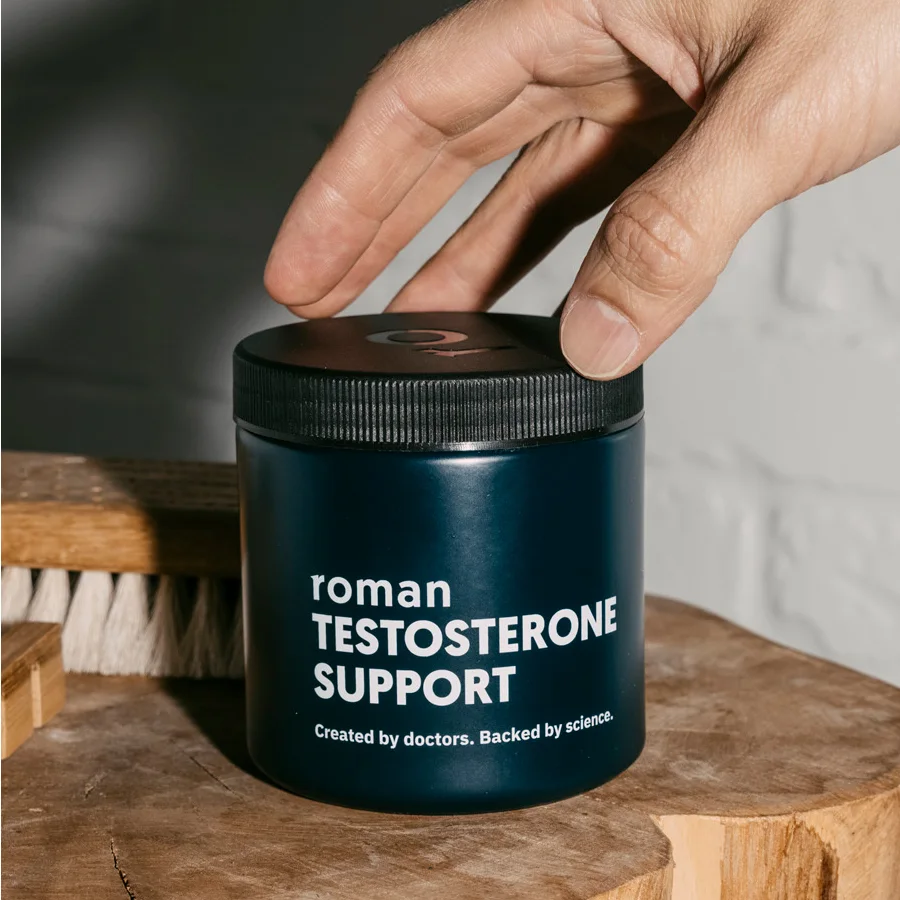Here's what we'll cover
Here's what we'll cover
Testosterone (T) therapy comes in many different forms. From a gel that you apply to your skin to a recently approved oral medication, long gone are the days when T therapy had to mean injecting yourself with a needle.
Testosterone undecanoate is one FDA-approved form of testosterone therapy that's available both as a long-acting injectable and as an oral medication. It can be beneficial for the treatment of hypogonadism and gender dysphoria. Continue reading to learn more about testosterone undecanoate.
What is testosterone undecanoate?
Testosterone undecanoate comes in two forms—an injectable form and an oral form.
The injectable form is most commonly prescribed under the brand name Aveed, which is a long-acting testosterone injection that only requires five injections per year. You’d need to give yourself an intramuscular injection, which can be uncomfortable, but this form of T has a long half-life. This means fewer injections each year than the other forms of testosterone available.
Jatenzo, Kyzatrex, and Tlando are all approved forms of testosterone undecanoate that come in capsules taken twice a day.
People who start testosterone therapy can generally see masculinization results (body and facial hair growth, deepening of the voice, etc.) within the first 1–2 months, while bone and muscle changes can take 6–12 months.
Testosterone undecanoate vs. other forms of T
In addition to testosterone undecanoate, there are a other versions of T available by prescription:
Testosterone cypionate, injectable (Depo-Testosterone)
Testosterone enanthate, injectable (Delatestryl)
Intranasal gel (Natesto)
Topical gel (Androgel, Fortesta, Testim)
The main advantage of taking injectable testosterone undecanoate over the other forms of injectable testosterone is that it requires fewer injections per year. This can be beneficial if you have trouble giving yourself a weekly injection. And, since testosterone undecanoate is the only form of testosterone also available in oral form, your healthcare provider may prescribe testosterone undecanoate if you’re a good candidate for oral testosterone therapy.
There are small differences in dosing and absorption between these different forms of testosterone. But, long story short, they’re all effective at raising your serum testosterone to “normal” levels. As with any medication, be sure to take the dose exactly as prescribed by a healthcare professional.
What does testosterone undecanoate treat?
Testosterone is known as an androgen or “male” sex hormone. But it’s actually a critical component in many bodily functions for all people.
T plays a role in the development of masculine features like body hair and lean muscle. It also plays a role in your bones’ strength and the way you process cholesterol. T levels can decrease for numerous reasons, and naturally decline with age. Other causes of low testosterone (or hypogonadism) include:
Damage to the pituitary gland (a gland in the brain responsible for sending the signal to your testes to make testosterone)
Deficiency of certain hormones
Cancer treatments
Low testosterone can cause mood changes, bone mineral density loss, and sexual dysfunction. Clinical trials have demonstrated that T is safe and effective in treating hypogonadism symptoms in cisgender men.
T has also shown significant benefits when prescribed to transgender men and nonbinary people who experience gender dysphoria. Studies show that T can achieve the following to treat gender dysphoria:
Increase facial and body hair
Increase lean muscle mass and strength
Decrease body fat
Deepen the voice
Increase sexual desire
Stop menstruation
Reduce stress, anxiety, and depression in transgender men
Another small study demonstrated that testosterone undecanoate is safe and effective over five years of follow-up. The symptoms of gender dysphoria diminished and satisfaction was achieved. Patients in another clinical study reported improved muscle strength and body composition.
Who should avoid taking T?
Older patients suffering from medical conditions like uncontrolled hypertension have a greater risk of side effects and should use testosterone with caution.
T should not be given to patients with breast cancer, prostate cancer, and specific blood conditions.
What are the possible side effects of taking testosterone?
Testosterone replacement therapy offers remarkable benefits for those that need it. But it does come with some risks.
Testosterone has the potential for abuse and should not be used in higher doses than prescribed. Taking T with anabolic steroids can cause life-threatening symptoms like a heart attack.
Whether you take injectable or oral T, there is some risk of side effects, including:
Alopecia (hair loss)
Hypertension (high blood pressure)
Increased prostate-specific antigen (PSA) levels, which may be correlated with an increased risk of prostate cancer
Increased breast cancer risk
Although rare, people taking any form of testosterone can experience an allergic reaction. If you experience side effects like hives, swelling, or difficulty breathing after your first dose, do not take your second dose and contact a healthcare provider.
If self-injections aren’t for you, oral testosterone undecanoate may be an option to treat low testosterone, gender dysphoria, and more. Whatever your concerns may be, make an appointment with your healthcare provider. They can help you develop a safe and effective treatment plan that meets your needs.
DISCLAIMER
If you have any medical questions or concerns, please talk to your healthcare provider. The articles on Health Guide are underpinned by peer-reviewed research and information drawn from medical societies and governmental agencies. However, they are not a substitute for professional medical advice, diagnosis, or treatment.
Basaria, S., Coviello, A. D., Travison, T. G., et al. (2010). Adverse events associated with testosterone administration. The New England Journal of Medicine , 363 (2), 109–122. doi: 10.1056/NEJMoa1000485. Retrieved from https://pubmed.ncbi.nlm.nih.gov/20592293/
DailyMed. (2022). Aveed-testosterone undecanoate capsule, liquid filled. Retrieved from https://dailymed.nlm.nih.gov/dailymed/drugInfo.cfm?setid=f80f025b-17d8-40af-8739-20ce07902045
DailyMed. (2022). Kyzatrex-testosterone undecanoate capsule, liquid filled. Retrieved from https://dailymed.nlm.nih.gov/dailymed/drugInfo.cfm?setid=7f7167a7-2a25-47e2-acf5-33f499fce971
DailyMed. (2022). Tlando-testosterone undecanoate capsule, liquid filled. Retrieved from https://dailymed.nlm.nih.gov/dailymed/drugInfo.cfm?setid=479b55bd-2023-486a-8922-3b1de48b935c
Elagizi, A., Köhler, T. S., & Lavie, C. J. (2018). Testosterone and cardiovascular health. Mayo Clinic Proceedings , 93 (1), 83–100. doi: 10.1016/j.mayocp.2017.11.006. Retrieved from https://pubmed.ncbi.nlm.nih.gov/29275030/
Gava, G., Mancini, I., Cerpolini, S., et al. (2018). Testosterone undecanoate and testosterone enanthate injections are both effective and safe in transmen over 5 years of administration. Clinical Endocrinology , 89 (6), 878–886. doi: 10.1111/cen.13821. Retrieved from https://pubmed.ncbi.nlm.nih.gov/30025172/
Gava, G., Armillotta, F., Pillastrini, P., et al. (2021). A randomized double-blind placebo-controlled pilot trial on the effects of testosterone undecanoate plus dutasteride or placebo on muscle strength, body composition, and metabolic profile in transmen. The Journal of Sexual Medicine, 18 (3), 646-655. doi: 10.1016/j.jsxm.2020.12.015. Retrieved from https://pubmed.ncbi.nlm.nih.gov/33531255/
Irwig, M. S. (2017). Testosterone therapy for transgender men. The Lancet. Diabetes & Endocrinology , 5 (4), 301–311. doi: 10.1016/S2213-8587(16)00036-X. Retrieved from https://pubmed.ncbi.nlm.nih.gov/27084565/
Minnemann, T., Schubert, M., Freude, S., et al. (2008). Comparison of a new long-acting testosterone undecanoate formulation vs. testosterone enanthate for intramuscular androgen therapy in male hypogonadism. Journal of Endocrinological Investigation , 31 (8), 718–723. doi: 10.1007/BF03346421. Retrieved from https://pubmed.ncbi.nlm.nih.gov/18852533/
Mulhall, J. P., Trost, L. W., Brannigan, R. E., et al. (2018). Evaluation and management of testosterone deficiency: AUA Guideline. The Journal of Urology , 200 (2), 423–432. doi: 10.1016/j.juro.2018.03.115. Retrieved from https://pubmed.ncbi.nlm.nih.gov/29601923/
Petering, R. C. & Brooks, N. A. (2017). Testosterone therapy: review of clinical applications. American Family Physician , 96 (7), 441–449. Retrieved from https://pubmed.ncbi.nlm.nih.gov/29094914/
Saad, F., Aversa, A., Isidori, A. M., et al. (2011). Onset of effects of testosterone treatment and time span until maximum effects are achieved. European Journal of Endocrinology, 165 (5), 675–685. doi: 10.1530/EJE-11-0221. Retrieved from https://pubmed.ncbi.nlm.nih.gov/21753068/
Sizar O. & Schwartz J. (2022). Hypogonadism. StatPearls . Retrieved on Feb. 17, 2023 from https://www.ncbi.nlm.nih.gov/books/NBK532933/
Swerdloff, R. S., Wang, C., White, W. B., et al. (2020). A new oral testosterone undecanoate formulation restores testosterone to normal concentrations in hypogonadal men. The Journal of Clinical Endocrinology and Metabolism , 105 (8), 2515–2531. doi: 10.1210/clinem/dgaa238. Retrieved from https://pubmed.ncbi.nlm.nih.gov/32382745/










